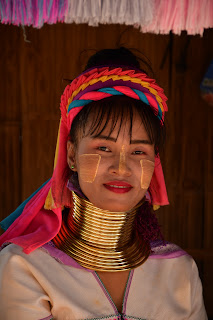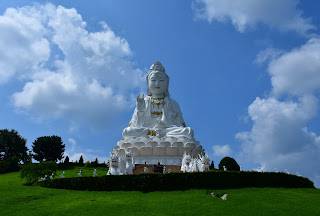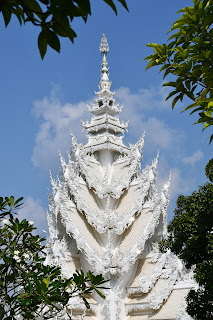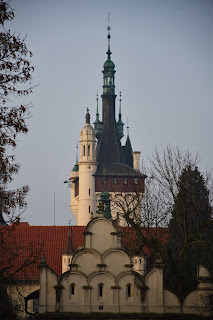A Saturday in Chiang Rai
This weekend, Reese and I travelled to Chiang Rai, a city nestled in the northernmost corner of Thailand, and so far north that local agencies offer two-day boat rides to Luang Prabang in Laos. Chiang Rai was founded in 1262 by King Mangrai, who named it after himself: the word “chiang” means city, so a loose translation of “Chiang Rai” would be “the City of (Mang) Rai.” Heir to the kingdom of Ngoenyang, Mangrai unified the city states (or mueangs) of northern Lanna and present-day northern Laos, establishing the Kingdom of Lanna.
Chiang Rai was momentarily the capital of the Mangrai
dynasty, but as Mangrai’s territory expanded, the capital was moved several
times until settling in Chiang Mai. In 1558, Burma conquered Chiang Mai, and
Chiang Rai remained under Burmese rule until 1786. One of Chiang Rai’s claims
to fame is that it is where Thailand’s palladium – the Emerald Buddha –
surfaced in 1434. The statue was likely created in the north of present-day
Thailand, but legend has it that it came all the way from India. According to Burmese
chronicles, the Emerald Buddha was promised to the Burmese king but ended up in
Cambodia because the ship carrying him was blown off course. According to
Cambodian chronicles, the statue was brought to Angkor Wat and was stolen
during a Thai invasion.
We arrived in Chiang Rai at eight o’clock in the evening on Friday and took a Grab cab to our hotel in the city centre. The next day, we rented a motorcycle from a contact of the hotel’s owners and began our exploration of the city. Our first stop was the Chiang Rai Clock Tower, a dramatically ornate golden structure standing at the intersection of two major roads. From there, we continued to Wat Mung Muang, a nineteenth-century temple famous for its big golden chedi and fat Buddha statue with comically oversized hands.
Charting a clockwise course around the centre of the
old town, we continued to Wat Phra Kaew, the ancient temple where the Emerald
Buddha was discovered. Of course, all the structures at Wat Phra Kaew are of a
newer provenance, but thanks to its extensive grounds and gardens overgrown
with shady trees, it maintains a calm and almost mystical atmosphere. At least,
I assume the place usually has a calm and mystical atmosphere; during our
visit, it was echoing with the sounds of chainsaws trimming the trees right in
front of the main temple.
Our last stop in the centre of Chiang Rai was Wat Phra
Sing, a fourteenth-century temple that was once home to Thailand’s second-most
revered Buddhist icon, the Phra Phuttha Sihing. Legend has it that this bronze
and golden image was cast in Sri Lanka two thousand years ago, eventually
making its way through several important Thai cities including Phitsanulok,
Ayutthaya, Kamphaeng Phet, Chiang Rai, and Chiang Mai. Somewhere along the way,
several images came to be identified with the Phra Phuttha Sihing. One is
currently housed in its own temple at the National Museum in Bangkok, another
in Nakhon Si Thammarat, and another in Chiang Mai.
We drove westwards from the temple and ascended the
mountain where Chiang Rai’s City Pillar Shrine now stands. Besides this
northern-style golden and red temple, the complex also houses an octagonal
golden stupa. The pillar itself stands at the centre of a platform surrounded
by dozens of smaller pillars, all of them wreathed in ceremonial cloths. There
is a small altar facing the circles of pillars behind which people pray, and
under which a very fat dog was resting while we were making our visit.
Riding across Kok River, we made our way to Wat Rong
Suea Ten, also known as the Blue Temple. True to its name, this modern
structure is entirely blue, from the phantasmagorical paintings on the inside
to the strange statues outside – including multi-headed elephants, winged
elephants, and finned elephants. Continuing northward, we made our next stop at
the Baan Dam Museum. The museum is a collection of wooden buildings built by
contemporary artists in the traditional regional style, or at least employing traditional
influences. It houses a host of bizarre items like animal skulls, crocodile
skins, and wooden phallic objects.
Being quite far north already, we continued another
ten minutes along the main road to a collective of villages. For an entry fee
of 300 Baht (one of the steepest entry fees in Thailand), the collective allows
tourists to walk around the mock habitations of several ethnicities. It is
essentially a more dignified human zoo than those of days past, the difference
being that the people have much more privacy and mostly interact with visitors by
selling souvenirs. The main “stars” of this village are the Long Neck Karen, a
people thus named because the women of this ethnic group wear large metal coils
to lengthen their necks. The coils do so by pressing the chest downwards, with additional
coils being added as a woman grows older.
The ethics of visiting such villages have been debated
on many webpages and I do not pretend to bring a new perspective to the debate,
let alone solve it. We decided to see the village out of curiosity, reasoning
that although it feels strange and voyeuristic to visit a place just to gawk at
its inhabitants, ethno-tourism is a significant source of income for many people
who are truly poor. Most of the Karen villagers in Thailand fled Burma due to
the civil war and have been unable to hold regular jobs because they have been
denied Thai citizenship.
Defenders of visiting such villages also argue that
women choose to wear neck coils of their own volition, but I fear I cannot be
as naïve. Impoverished Karen women clearly realise that they stand to gain
money from tourists by continuing to deform their bodies, which means tourism
is at least partly responsible for the survival of this questionable practice. During
our visit, we saw many young girls who have already started wearing neck coils,
and I imagine that by adulthood such a young woman’s neck can already be long
and brittle, which would likely discourage her from discarding the coils even
if she wanted to.
Whether visiting a Karen village is ethical or not,
there are certainly ways to behave ethically and unethically as an individual. We
made sure to ask people whether we could take their picture, saying hello and
making some small talk as we passed by. The little girls appeared particularly
pleased when we gave them compliments on their clothes, and the adult women just
seemed happy to be greeted in the standard, respectful fashion.
Since the route between the village and our next stop was
less busy and relatively well-paved, Reese finally relented and let me drive
the motorcycle. The mechanics were simpler than I expected, but turning and
maintaining balance proved surprisingly difficult with two people on board. To
stay on the safe side, I drove the next sixteen kilometres at a speed that
never reached fifty kilometres per hour. It annoyed Reese a little, but I believe
he had to recognise that one is better off safe than dead.
We only made a brief stop at Wat Huay Pla Kang, a Chinese-style
temple with a nine-tiered pagoda and giant white Guanyin statue. Just six or
seven kilometres west of Chiang Rai airport, the Guanyin statue was the first
structure we saw as we descended the previous evening. From the temple, we
drove our longest stretch yet, traversing the twenty kilometres of roads that
separate Wat Huay Pla Kang from Wat Rong Khun, the famous White Temple.
Designed by the eccentric artist Chalermchai Kositpipat, Wat Rong Khun is a blindingly
bright, gaudily ornate and puzzlingly extensive structure. Deviating from the
white exterior, its main prayer hall is covered in trippy paintings, which
incorporate various far-flung characters like the Minions and Doraemon.
Returning to the city, we made one last stop at Wat
Phrathat Doi Khao Kwai, a glittering stupa that stands atop a hill overlooking the
city. While it usually offers a good view of Chiang Rai and the surrounding
hills, the air was a bit hazy, and we were in any case a bit too tired by then
to really take in our surroundings. When we got back, Reese went to take a rest
while I made one last circle around the old centre. I reprised our earlier stop
by the Chiang Rai Clock Tower and Wat Phra Sing, continuing to the Old City
Hall and Wat Klang Wiang.
In the evening, we visited the “Saturday Market” set
up along Thanalai Street, which is nicknamed “Walking Street” because it closes
to cars for this weekly event. The place was bustling. Visitors flowed in two
currents past the stalls, buying all sorts of food from quail eggs and durians
to grilled squid. On some of the streets branching off from the main street
stood marquees under which people received massages. However, the most
interesting part of the market was the stall selling live Siamese rhinoceros
beetles, each of which was tied by its horn to its own sugar cane stem. These
insects are kept for beetle fighting, a popular spectator sport during which the
beetles try to lift each other with their horns.

























































Comments
Post a Comment